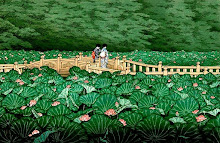Japan Gripped by Suicide Epidemic
Japanese professionals in their thirties are killing themselves at unprecedented rates, as the nation struggles with a runaway suicide epidemic.
Newly published figures show that 30,093 people took their own lives in 2007 — a 2.9 per cent increase in a year — leaving the country as the most suicide-prone anywhere in the developed world and rendering government efforts to combat the problem a failure.
Suicide rates remained highest among men — at 71 per cent of the total — and very high among Japan's rising population of over-60s. Geographically, most suicides took place in the prefecture of Yamanashi, where the forested foothills of Mount Fuji continue to attract the suicidal from around Japan.
Government analysis of the figures, for the tenth year consecutive in which suicides have remained above 30,000 mark, has exposed a series of new and troubling trends: people in their thirties are the most likely to kill themselves, and work-related depression is emerging as a prime motive.
Psychologists, sociologists and other close observers of Japanese society believe that the country is in the grip of a full-blown crisis among its young working population. Experts say thathigh suicide rates and the recent spate of random stabbings in public places are symptoms of a malaise that the country has ignored for too long.
Mika Tsutsumi, an economist and social analyst, said that the recent stabbings in Akihabara were worryingly predictable: the killing spree for which Tomohiro Kato was allegedly responsible was, she says, driven by a sense of hopelessness in the workplace. Underneath Japanese society is concealed "an invisible reserve army of Katos", she said.
Even more disturbing than the raw suicide figures, said police, was the astounding recent surge in people who have taken their lives by generating highly poisonous hydrogen sulphide gas from a combination of standard household products.
Unlike more traditional methods such as hanging or drugs overdoses, the production of hydrogen sulphide endangers people in the same building and turns what used to be private despair into a public event.
Tweenty-nine people used that method to end their lives last year, but after the formula for the gas was circulated widely on various "suicide websites", it has taken on a sinister appeal to the desperate and lonely.
Since February this year, 517 people have killed themselves using the gas, about half of them in their twenties, and its macabre popularity as a method of self-destruction shows no sign of waning.
The crisis of despair gripping young working Japanese has triggered plenty of official and media hand-wringing, though little in the way of change in corporate Japan. Wages remain low, and hierarchies rigid.
"We live in an uncomfortable and restrictive society where trivial matters are important," said Professor Kiyohiko Ikeda, a veteran social commentator at Waseda University. "The young feel a sense of deadlock; society does not accept minor mistakes."
- thanks to Billy Amason for sending this to me via email
- Times Online
Newly published figures show that 30,093 people took their own lives in 2007 — a 2.9 per cent increase in a year — leaving the country as the most suicide-prone anywhere in the developed world and rendering government efforts to combat the problem a failure.
Suicide rates remained highest among men — at 71 per cent of the total — and very high among Japan's rising population of over-60s. Geographically, most suicides took place in the prefecture of Yamanashi, where the forested foothills of Mount Fuji continue to attract the suicidal from around Japan.
Government analysis of the figures, for the tenth year consecutive in which suicides have remained above 30,000 mark, has exposed a series of new and troubling trends: people in their thirties are the most likely to kill themselves, and work-related depression is emerging as a prime motive.
Psychologists, sociologists and other close observers of Japanese society believe that the country is in the grip of a full-blown crisis among its young working population. Experts say thathigh suicide rates and the recent spate of random stabbings in public places are symptoms of a malaise that the country has ignored for too long.
Mika Tsutsumi, an economist and social analyst, said that the recent stabbings in Akihabara were worryingly predictable: the killing spree for which Tomohiro Kato was allegedly responsible was, she says, driven by a sense of hopelessness in the workplace. Underneath Japanese society is concealed "an invisible reserve army of Katos", she said.
Even more disturbing than the raw suicide figures, said police, was the astounding recent surge in people who have taken their lives by generating highly poisonous hydrogen sulphide gas from a combination of standard household products.
Unlike more traditional methods such as hanging or drugs overdoses, the production of hydrogen sulphide endangers people in the same building and turns what used to be private despair into a public event.
Tweenty-nine people used that method to end their lives last year, but after the formula for the gas was circulated widely on various "suicide websites", it has taken on a sinister appeal to the desperate and lonely.
Since February this year, 517 people have killed themselves using the gas, about half of them in their twenties, and its macabre popularity as a method of self-destruction shows no sign of waning.
The crisis of despair gripping young working Japanese has triggered plenty of official and media hand-wringing, though little in the way of change in corporate Japan. Wages remain low, and hierarchies rigid.
"We live in an uncomfortable and restrictive society where trivial matters are important," said Professor Kiyohiko Ikeda, a veteran social commentator at Waseda University. "The young feel a sense of deadlock; society does not accept minor mistakes."
- thanks to Billy Amason for sending this to me via email
- Times Online





